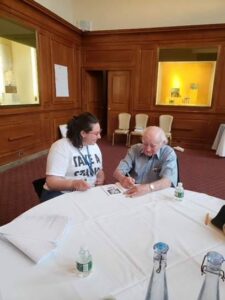
After 12 years of getting the same bewildered look from people when I explain that I truly feel like the Illinois Holocaust Museum is like a 2nd home, I have grown accustomed to explaining myself. And to people that I really know, I might even go so far as to share that my passion for Holocaust studies has been a way of healing. Though it’s difficult and complicated to explain why I am devoted to this subject, I have found a safe, welcoming, and groundbreaking place where the mutual goal is fostering growth and understanding.
After about 5 years, I had become a ‘regular’ at the professional development seminars offered by the museum. So, in 2012, I became a Fellow of the museum after having the privilege of attending the weeklong seminar. Then, in 2016, I was invited to sit on the Educator Advisory Council (EAC), where I would be able to help contribute and give back to the museum that had already given and invested so much in me. And, in the spring of 2018, I was given the chance to present at the museum. I felt empowered and supported like I never had before! Then, I got the email.
I had been asked to represent the museum (in addition to another fabulous EAC member and friend, Keisha Rembert) at the 2018 Jewish Foundation for the Righteous (JFR) Summer Fellows Program in New York City. This opportunity would be given to me as an Irena Sendler Fellow of the Illinois Holocaust Museum in conjunction with the Alfred Lerner Fellowship of Columbia University. Studying with the JFR would mean that I would be learning from some of the most imminent scholars in the field, including Peter Hayes, Daniel Greene and… Roman Kent (JFR Board President, Entrepreneur and Holocaust survivor)! I also would have access to other educators from across the country and Europe to strategize about pedagogical connections, opportunities for student engagement, and further analysis of the implications of the presentations.
Prior to arriving in New York, I was required to read a substantial amount, however, everything that I read provided me with some kind of new information that I would be able to take back to my classroom. The primary source we used was Peter Hayes’ book, How was it Possible. This anthology of topics, as well as his insightful and concise introductions, provided me with a fantastic ‘refresher’ course prior to attending. The Alfred Lerner Fellows are hosted on Columbia University’s campus. During our stay there, we spent a considerable amount of time in gorgeous ambiance of Low Library and were graciously hosted at the Faculty House.
During the seminar I was able to pick the brains of my academic idols and learn about emerging topics within the field, like the Holocaust in the East. One of the most important revelations I had during this time had to do with the information that related to the Holocaust in the East. Even as a seasoned teacher and avid student of ILHMEC, I found myself thinking, Whoa…I have only been teaching half of the story?! When I mentioned this to Kelley Szany and Amanda Friedeman recently, and admitted that I couldn’t believe that I had been ‘doing it wrong’ for all these years, I was once again safe as they reassured me that collectively, we are all just starting to really learn about this topic. And just like that, I find myself feeling overwhelmed with gratitude and appreciation for the institution that has not only made me a better student of the subject, a better teacher to my students, but hopefully a better person in the world.
Next spring marks the 10th anniversary of the Illinois Holocaust Memorial and Education Center’s location. The past 10 years have enriched my life, my work, and my students. I invite you to come and see what the museum can offer you and your students this school year. Our ILHMEC is not just a place to learn about WWII, the Holocaust and genocide history. This is a safe place where we can grow and learn about empathy and understanding, and these lessons permeate life.
